
#365Convos is our initiative to encourage dialogue around mental health and suicide prevention throughout our community 365 days of the year. It was announced on Bell Let’s Talk Day 2021 in recognition of the fact that mental health is important every day – not just on days where the media spotlights. In this year-long initiative, we will investigate various monthly topics and share weekly posts to encourage you to continue your own dialogue. Follow our social media channels by following the links in the footer below to engage with us throughout this initiative.
Together as a community, we can have #365Convos, 365 days of the year.
View our original campaign launch announcement here.

Our theme for February is language and myths. The language we use and the beliefs we hold around suicide can be stigmatizing, and even harmful. This month’s content will provide the basis for having safe and stigma-free discussions on suicide as we join together in #365Convos. Check back each week to view the week’s content.
Language & Myths 1: A conversation with Ed Mantler, VP Programs and Priorities, Mental Health Commission of Canada
This week in #365Convos we share a video that our friends and colleagues at the Mental Health Commission of Canada filmed for us. This video features Ed Mantler, VP of Programs and Priorities, speaking about the importance of safe language and communication in online platforms. It is important to remember that words matter! In all of our conversations or communications, whether virtual or in-person, it is important to talk and share safely about suicide and the work of prevention so that we can create spaces where people can offer or seek help.
Language and Myths #2: Language Matters


Today in #365Convos, we are going to consider our language. Specifically, the ways in which language can be harmful or helpful. While we continue to encourage conversations each day of the year, we want to ensure that our words are welcoming rather than stigmatizing. In reflection this week, consider the ways in which you can adjust your language to promote healthy conversation. Take a look at our images above to find some ideas for how to get started. The content in these images has been directly adapted from Language Matters: Safe Communication for Suicide Prevention, created by the Public Health Agency of Canada in partnership with Centre for Suicide Prevention and l’Association québécoise de prévention du suicide.
Language and Myths #3: Myths Pt.1






Today in #365Convos, we want to combat some common myths about suicide by presenting you with the information you need to know. Above, you will see a series of myths and facts. Reflect on which one stood out the most? Were any surprising to you? Consider how you might share these facts, to try to remove misinformation from our continued conversations.
Language and Myths #4: Myths Pt.2






Today in #365Convos, we have more myths and facts to share. We want to ensure that our continued conversations are honest, caring and free from misinformation. Consider all information about suicide you may have heard, think about which sources you heard it from, and question how you might ensure information you share is factual and helpful and works towards breaking down stigma.

During the month of March in #365Convos we will look at risk factors, warning signs, and protective factors for suicide. While there is no one blueprint for identifying someone who might be thinking of suicide (not everyone will have the same risk factors or warning signs), we can learn to recognize changes in our family and friends that may indicate they are struggling and can use what we notice as a way to start a conversation. We can also learn about protective factors and how to promote them in ourselves and others to decrease the potential risk of suicide. We invite you to join us this month in talking about risk factors, warning signs, protective factors with your friends, family, colleagues, and loved ones. Together as a community, we can have #365Convos, 365 days of the year.
Risk factors, Warning Signs, & Protective Factors #1: Risk Factors
Today in #365Convos, we define risk factors and warning signs. We also will provide examples of risk factors, which may increase the potential for someone to think about suicide. As you read through these examples consider how these listed risk factors could play a role in forming thoughts of suicide. If you or anyone around you has experienced these risk factors, think about what impact they created, or how you or others may have coped with experiencing these factors. It is important to remember that not everyone who experiences these risk factors will think about suicide, and also that someone may have thoughts of suicide without having experienced any of these listed factors. Think of these risks factors as events or experiences where you or a friend may benefit from a supportive conversation. Next week, we’ll explore warning signs that one may exhibit if thoughts of suicide are forming. Learn more at wrspc.ca/understanding-suicide/risk-factors-warning-signs/


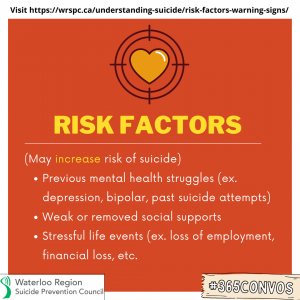

Risk factors, Warning Signs, & Protective Factors #2: Warning Signs
Today in #365Convos, we will further consider warning signs. Now that you know some possible risk factors, explore these images and consider what warning signs may look like for you of others around you. Warning signs can act as an alert system, and as invitations for help. If you notice yourself or someone around you showing these signs, it might be time to have a supportive and caring conversation. Reflect on what warning signs you show when you’re struggling or experiencing heightened stress – and what warning signs have you noticed for those you are close to? Check in next week as we shift to looking at protective factors, and learn more at wrspc.ca/understanding-suicide/risk-factors-warning-signs/



Risk factors, Warning Signs, & Protective Factors #3: Protective Factors
This week in #365Convos, we want to share protective factors. Protective factors can protect us against the potential negative impacts of stressors and risk factors we may experience, and therefore can decrease the risk of suicide. This week, reflect on what protective factors are present in your life. How can you build your protective factors to prepare ahead for hard times that may come? How can you be a protective factors, or promote protective factors, for someone close to you? Have conversations about protective factors with those around you. One protective factor is access to supports. We’ll be exploring community supports in more depth in a later month, but some supports you can keep in mind as you build your protective factors might include Here 24/7 (here247.ca) and Kids Help Phone (kidshelpphone.ca). View our series on Resilience and Protective factors on our website for more details: wrspc.ca/category/resilience-protective-factors/

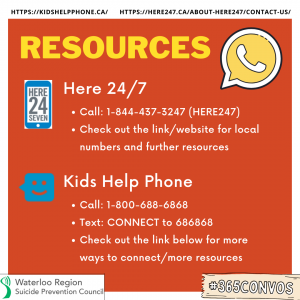
Risk factors, Warning Signs, & Protective Factors #4: What about COVID-19?
Today in #365Convos, we wanted to mention that risk factors, warning signs, and protective factors might look different during COVID-19. Consider how you can still check-in with loved ones virtually, and how you might adapt to changes in your usual protective factors, including how you might build new ones. How might we continue to check-in with ourselves and others during a time of decreased face-to-face contact? For a more in-depth exploration of Suicide Alertness during COVID-19, wrspc.ca/suicide-alertness-during-covid-19/ and for resources available during this time visit https://wrspc.ca/maintaining-mental-wellness-during-covid-19/
Tune in next week for a special guest video exploring risk factors, warning signs, and resilience factors that parents can watch for in their youth.

Risk factors, Warning Signs, & Protective Factors #5: A Conversation with Stephanie Mattie
Wrapping up March’s #365Convos topic of risk factors, warning signs, and protective factors, we talk to Stephanie Mattie, a Mobile Crisis Worker with Carizon at Front Door: Access to Child & Youth Mental Health Services. We talk about how these things show up for youth. Stay tuned next month as we move into April’s topic of how to have a conversation, and kick things off with another guest video.

Welcome to April and to this months #365Convos topic which is “How to Have a Conversation”. Now that we have covered safe language, myths and facts, and warning signs and risk factors, this month we will share some guidance on how to have a conversation with someone about suicide when you think they may be struggling. We will kick off the month next Monday with a special guest video from our partners at CMHA Waterloo Wellington.
Monday April 5: Guest video – Laura McShane, CMHA Waterloo Wellington
Today in #365Convos, we share with you a conversation with Laura McShane, Coordinator of Mental Health Promotion and Education at CMHA Waterloo Wellington. Laura is also member of WRSPC’s advisory council, a member of Suicide Action Wilmot Wellesley, and a Livingworks SafeTALK trainer. In this conversation, Laura chats with WRSPC Program Coordinator Amanda about how to have a conversation with someone who might be thinking of suicide.
Monday April 12th: The Golden Rules & Some Tips
Today in #365Convos, we are sharing some quick tips from two great resources. First, we have Jack.Org’s resource Bethere.org and their “Golden Rules for Starting a Conversation About Suicide”. This resource provides 5 clear rules to follow when supporting someone with their mental health. Learn more on their website at www.bethere.org.


Today we also have some tips that come from the Centre for Suicide Prevention’s video: “Talk to Someone About Suicide”. These are helpful reminders for what to do while having a conversation about suicide. The video itself presents even more pointers, in a comprehensive way. View their full video here.


This week, think about which of these tips resonates with you, and think about how you might apply them in the next conversation you have with a friend who you think is struggling. Share this tips with others to create a caring community around you.
Monday April 19: Being a Better Listener
This week in #365Convos, we are sharing some guidance and tips collected from articles by the Mental Health Commission of Canada around how to be a better listener. Explore these images to learn about active listening, how we can be a mirror, and the dangers of ‘At least’. It can be common to want to put a positive spin on someone’s experience by saying ‘At least…’ but by doing this, we may be dismissing or diminishing a person’s real feelings and experiences, and may be further harming them through creating guilt or shame about what they feel. During COVID-19, our ability to be there for one another has shifted and we have had to find new ways to connect and check in with one another. Remember that your health is also important. While we continue to have conversations and be active listeners for others, we can also listen to our own needs. This week, consider how you can be a helpful listener in conversations and the ways in which you can listen internally to your own needs as well.




Monday April 26th: Considerations When Sharing your Experience
Today in #365Convos, we will provide you with some resources for people who want to share about their own experiences. Take a look at these images for some questions to ask yourself before you share, as well as some helpful tips on how to share safely if you decide to share with someone. Although these posts focus on online sharing, you can also apply them when thinking about when and how to share with someone in-person as well. These tips come from Orygen’s #Chatsafe guidelines, accessible here. As we come to the end of April, reflect on what you’ve learned this month, and consider how you can be a safe conversation starter and an active listener. Join us next month as we continue our #365Convos by exploring mental health resources and crisis supports in our community.






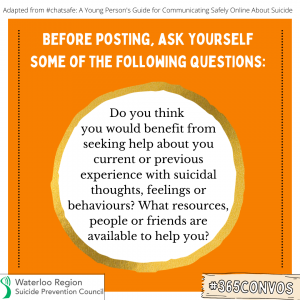

Welcome to May! This month in #365Convos, we wanted to provide some very practical mental health supports and crisis resources. This month we will have websites, chat options, phone numbers, crisis safety planning, and local counselling service options for you to explore. This month, consider what resources you already know of, have used previously, or have access to in case you or someone you know is in need of help. When looking at the resources presented this month, consider adding some of the numbers to your phone or writing them down somewhere easily accessible. We’re better able to navigate a crisis that we or someone else is going to if we feel prepared for it by knowing what resources can help in that situation.
Monday May 3: Guest video – Brenda Richard, Self-Help & Peer Support, CMHA Waterloo Wellington
Today in #365Convos, we share with you a conversation with Brenda Richard, Facilitator of Self-Help and Peer Support at CMHA Waterloo Wellington. Brenda is a Peer Support Canada Certified Peer Supporter, and also a longstanding volunteer with WRSPC. In this conversation, Brenda chats with WRSPC Program Coordinator Amanda to share information about Peer Support, and the services Self-Help and Peer Support offers.
Monday May 10th: Mental Health Support and Crisis Services
This week in #365Convos, we are sharing some phone numbers for text and calling as well as some website resources. The phone numbers can be used when you, or someone you know, needs to talk. Sometimes these services also provide an online chat box or an app version as well. The websites offered are generally more useful in gathering resources and information. Generally, the websites act as redirection for phone/text services. However, they have plenty of information about suicide prevention, and other mental health resources (in a variety of formats too). This week, consider checking out a website to gather some helpful tips for mental health. Next week, we will highlight some services that provide a “What to Expect”, in hopes of alleviating some of the uncertainty of the unknowns that arise from considering using these services.



Monday May 17: What to Expect
This week in #365 Convos, we want to offer a couple profiles of what to expect with different services. The three we will highlight this week are Here24/7, the Canada Suicide Prevention Services, and Kids Help Phone. Each of these services have provided articles of frequently asked questions or a step by step of what to expect when using their service. We hope that you will check out the websites, you may find comfort in knowing what to expect, or being able to explain to a loved one what they might expect from these services.



Monday May 24: Crisis Safety Plans
This week in #365Convos, we want to give a potential outline of a Crisis Safety plan. These templates can be adjusted as needed, but are intended to hold your information in one place, so that it is easily accessible in a crisis situation. There are printable versions of these cards, and also you may find an app, or just simply consider adding this to your phone or wallet for safe keeping. This week, consider creating your own crisis safety plan and finding an accessible place to keep it.


Monday May 31:
In this final week of Crisis Resources for the month of May in #365Convos, we want to offer some suggestions for local counselling and mental health services. While there are plenty more to offer, we provided some highlights with website links that you may want to consider. These services are preventive, and are not commonly intended to be used in crisis situations. Please check with the resource first to best understand what services it can provide. For a more in-depth list of sources, please check out https://wrspc.ca/maintaining-mental-wellness-during-covid-19/ and stay tuned for next month’s conversation, “Self-Care”.






Welcome to June! This is our sixth month-iversary of #365Convos. We are thrilled to continue having conversations within and with our community. This month’s theme is Self-Care. This month we will be exploring what ‘self-care’ really is, sharing some self-care ideas, and sharing some tools. As we continue to have conversations about mental health and suicide, a parallel conversation is one around self-care – how we can practice self-care for ourselves, and how we can allow for and encourage self-care for others. Sometimes we need a break to re-energize and this is okay. We can’t fill from an empty bucket. This month, begin to consider the ways in which you might take care of your own health, particularly when many other responsibilities (work, family, etc) can sometimes push our own care to the backseat. Have conversations with those around you about self-care, and how you can support each other in caring for yourselves.
Monday June 7: Guest video – Adrienne Luft, WRSPC Board Chair and Registered Social Worker
Today in #365Convos, we share with you a conversation between WRSPC Executive Director Elisa and Board Chair Adrienne. Adrienne shares some insights into how we can really make self-care a practice to protect ourselves and promote our own mental wellness.
Monday June 14: Self-Care Tools
This week in #365Convos, we are sharing one tool for reflection on our mental health. This tool provides a handful of topics to write about (although there are many more that you could also work with) and this tool can be adapted to meet your needs. The overall idea is that reflection can aid in growth. If you are struggling to come up with next steps, or ideas to write about, you can check out the Brainstorm image. This week, consider what ways you may already be reflecting, and how you might build those skills into a routine to ensure you check in/take care of your mental health too. You can also use these reflection topics as conversation topics with those close to you, to talk about how you can mutually support self-care for the other.

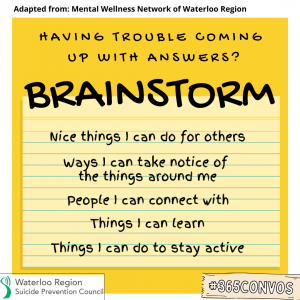
Monday June 21: Wheel of Wellbeing
This week in #365 Convos, we want to present and explain a tool created by Kids Help Phone: The Wheel of Wellbeing. This wheel presents an opportunity to consider the interconnected nature of different parts of our wellbeing. No piece of our health can be considered in isolation. By using a tool such as the Wheel of Wellbeing, and trying to grasp the different areas that we are succeeding in, and the ones that need some extra attention, we can more easily pinpoint a strategy to move forward. These wheels offer more of a holistic approach to our health and wellbeing. This week consider looking at a few of the pieces of the wheel to see which areas could use your attention, and ways in which you can attend to those needs. Have conversations with friends and family to share your needs, or ask them about their wellbeing strategies.




Monday June 28: More Self-Care Ideas
In this final week of Self Care in #365Convos, we want to offer some ideas to help you practice self-care. Self-care is quite individualistic and everyone will have their own self-care strategies to protect and promote their mental wellness. The key is to build some time into our lives for self-care, as it is pivotal in allowing us to thrive in our lives, handle stresses, and to support and help others effectively. When we are able to love and care for ourselves, we are better able to love and care for others. This week, consider the resources you have gathered this month, and what other resources you know of, that you can work into your life so that you can take care of yourself and your mental health. For more information check out https://wrspc.ca/life-promotion/


Welcome to July! Throughout the summer months of July and August, #365Convos will be exploring resilience and protective factors through the framework of Hope, Belonging, Meaning, and Purpose. We will explore where this framework comes from, and what these concepts mean. Join us in continuing the dialogue 365 days of the year.
Monday July 5: Introducing Hope, Belonging, Meaning, & Purpose
This week in #365Convos, we want to share an overview of where the Hope, Belonging, Meaning and Purpose framework came from, and how it is being used practically today. This framework, part of the First Nations Mental Wellness Continuum, was developed by the Thunderbird Partnership in collaboration with Health Canada. Protective factors were seen as healthy and necessary aspects to building resilience, and can be summarized into these four categories within this framework. This week, reflect on what these words mean to you. Can you see how they might connect to building and maintaining mental wellness?



Monday July 12: An Interview with Mara Grunau, Executive Director, Centre for Suicide Prevention
Today in #365Convos we share an interview between Amanda and Mara Grunau, Executive Director for the Centre for Suicide Prevention in Calgary, AB. Mara shares with us where the Hope, Belonging, Meaning, and Purpose framework comes from, and what it means to her. Stay tuned throughout July and August as we delve into these concepts further.
Monday July 19: Hope
This week in #365Convos we will focus on hope. The above quote, “Hope drives optimism about tomorrow”, allows us to consider the ways in which we may find hope. We want to especially consider how we might continue to find hope in uncertain times. This week, consider the ways in which our conversations may contributed to our ability to experience hope. What ways have you sought out hope in the past year? How can you have conversations in a way that might promote hope?


Monday July 26: Belonging
This week in #365Convos we will focus on belonging. Throughout our #365Convos, we have continued to emphasize the need for conversations and community. Belonging allows for us to feel connected and know that we are not alone. Consider the ways in which a sense of belonging contributes to your mental health. How can we continue to create belonging in our lives, and how can we have inclusive conversations that promote a sense of belonging for others?


 Welcome to August! This month in #365Convos, we will be continuing our conversation on Hope, Belonging, Meaning & Purpose. We will specifically focus on meaning and purpose. As we enter this new month, reflect on the understanding you may have discovered while learning about Hope and Belonging. This week, consider what meaning and purpose may look like in our lives. We will discuss these second two pieces in more detail this month. Join us in reflecting on how meaning and purpose impact our wellbeing, and how we might dive deeper into the hope, belonging, meaning and purpose framework, to improve our mental health.
Welcome to August! This month in #365Convos, we will be continuing our conversation on Hope, Belonging, Meaning & Purpose. We will specifically focus on meaning and purpose. As we enter this new month, reflect on the understanding you may have discovered while learning about Hope and Belonging. This week, consider what meaning and purpose may look like in our lives. We will discuss these second two pieces in more detail this month. Join us in reflecting on how meaning and purpose impact our wellbeing, and how we might dive deeper into the hope, belonging, meaning and purpose framework, to improve our mental health.
Monday August 2: Meaning
This week in #365Convos we will consider the third piece of hope, belonging, meaning & purpose framework. Where do we find meaning? “Meaning is created by an attitude towards living”. Meaning is similar to purpose; it reminds us that our lives are worth living. Creating meaning allows us to see something deeper about our lives. When we are able to find meaning in our purpose, we may have the inspiration needed to thrive. We may be less likely to be bound by our circumstances, as we know that there is a greater purpose and meaning for our lives. This week, consider the ways you create or may begin to find meaning in your life? How might meaning act as a tool for healthier living?


Monday August 9: Purpose
This week in #365Convos we will share an overview of Purpose, which is the final piece of the framework. “Purpose creates an understanding that every person is sacred, that the physical body is “home” for the spirit, heart and mind, all of which are interconnected to the other and work inseparably”. In finding purpose, we are reminded of the value of life and the ways in which we may continue to recognize the reasons for living. Finding purpose allows for an extra layer of resiliency in the face of hardship; “they remind us that no matter what else is going on, ‘I matter’.” This week, consider what tools can help one find their purpose, and develop their reasons for living. Consider how we might use purpose as a tool during challenging times?


Monday August 16: Hope, Belonging, Meaning and Purpose
This week in #365Convos, as we finish up our Hope, Belonging, Meaning and Purpose content, we want to reflect back on each piece of this wellness approach. Consider the ways in which we might begin to use the concepts of hope, belonging, meaning and purpose in strengthening our mental health, and improving our care practices. Review the past #365Convos we have had this year. Where might past content tie into the Hope, Belonging, Meaning and Purpose Framework? What intersections are there between this framework and past shared resources? How might we continue to use all of our learning to improve our mental health?
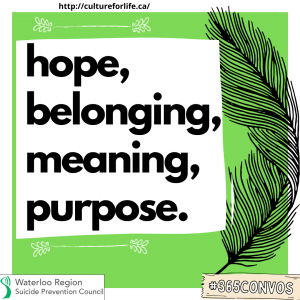




Monday August 23: Hope, Belonging, Meaning and Purpose by Culture for Life
Monday August 30: Symbols


Monday September 6: Short History and Overview of World Suicide Prevention Day



Monday September 13: World Suicide Prevention Day
Today in #365Convos, we are sharing the video from the 2021 World Suicide Prevention Day Ceremony and Butterfly Release. This year’s theme was “Creating Hope Through Action”. Our guest speakers addressed different ways of creating hope through action on a community level, systems level, and individual level. They help us to remember that we all have a role to play. Check out this year’s World Suicide Prevention Day Ceremony and Butterfly Release video: https://vimeo.com/601302583
Monday September 20: Living Works START Training
Today in #365Convos, we are providing a short overview of the LivingWorks Start training. This suicide prevention training program requires no previous knowledge to participate. It acts as another great resource to expand our learning and help us to be active in suicide prevention. This week, consider other strategies, resources and materials we might use in suicide prevention. Reflect on the content from last week. What did you take away from World Suicide Prevention Day? How might we continue to learn and use what we have learned in our everyday lives?

Monday September 27: Creating Hope Through Action


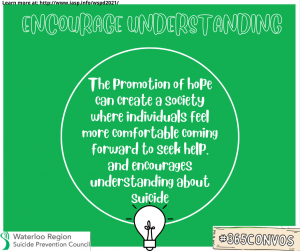


Monday October 4:
Monday October 11:
Today in #365Convos, we share the second part of a 3-part conversation with Umi Mohammed, the Equity Leader with Lutherwood. In this conversation Umi chats with WRSPC Student Eve about “How can we listen to the voices of those with lived and living experiences? How do we ensure that the right voices are amplified in this work?”.
Monday October 18:
Today in #365Convos, we share with you third and final part of our 3-part conversation with Umi Mohammed, the Equity Leader with Lutherwood. In this conversation Umi chats with WRSPC Student Eve about “How can we make sure that mental health resources are accessible and equitable?” Thank you for joining us for this three-week conversation.
Monday October 25:
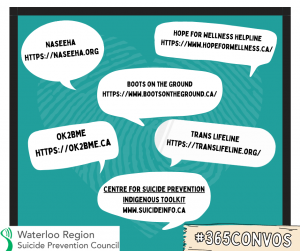

Monday November 8:




Monday November 15:
This week in #365Convos, we are continuing our conversation from last week, by offering some further ways to help someone who is grieving. Consider how we might keep these tools in our back pocket, so that we are ready should we need to support someone in this way. This week, reflect on the resources of the last couple of weeks and consider how we might apply them to our lives or relationships.


Monday November 22:
Monday November 29:
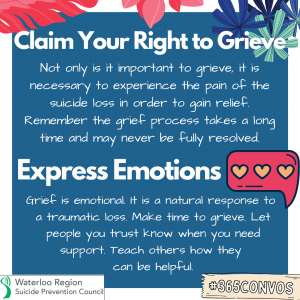

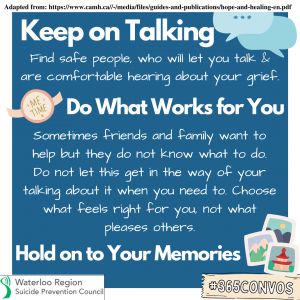


Monday December 6:

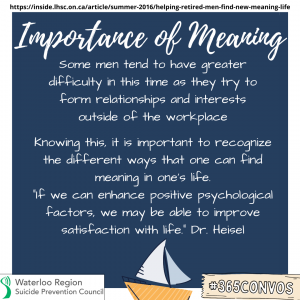


Monday December 13:
This week in #365Convos, we are focusing on the transitions that may be experienced by older adults. We start by presenting what some of these changes may be, and the feelings that may be associated with these transitions. We then provide some ideas for how to cope with life changes, and some tips for working through life transitions, particularly in the lives of older adults. Reflect on some ways in which you may have worked through past transition periods. How might some of the strategies you used then help you in your next transition? How might you be best prepared for transitions? What supports can you lean on during difficult transitional times?



Monday December 20:



Monday December 27:
This week in #365Convos we are going to focus on new year transitions as 2021 is drawing to a close. A new year often results in people making New Year’s resolutions about themselves and things they would like to change for the upcoming year. With this in mind we would like to share several different ideas to be mindful of as you set our goals for 2022 including self-compassion and how you want to be in the world with yourself and others.

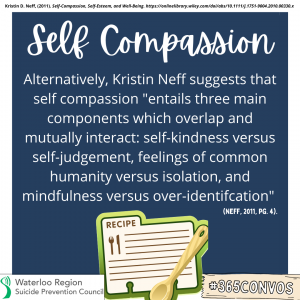



Monday January 3:

Monday January 10:
This week in #365Convos we are going to hear from our next community member as we focus on the role that each of us plays in the work of suicide prevention. Today we have a quote from Kathy Payette Director, Children’s Mental Health, Lutherwood.
1.) What do you see as your roll in continuing the important conversation around suicide prevention? How have you continued the conversation?
I need to start with a personal story: My 12 year old grandson, lost two men he looked up to by suicide this past year. One was a neighbour who always encouraged him to join in on fixing a car or building a shed; the other a young man who was a volunteer at Sam’s outdoor school and who taught him how to whittle and use the outdoors as a space to learn and grow. Today, my grandson is doing OK – his mother is very in tune to hie needs, but he is a feelings kind of kid and it has been a sad and sometimes difficult journey for him….but it opened up for conversation about suicide, feelings, caring and each person’s way of dealing with whatever they feel and do when a person close to them dies by suicide.
As a mom, a professional working in the field of mental health, as a colleague, a friend, a neighbourhood…as a member of our society – how what is my role? First and foremost I think it is to ensure those I have contact with feel heard, know they are loved, know they have someone willing to walk beside them wherever their journey takes them. My first stance when with I am with someone who is struggling or in crisis is to ask myself – How can I empower this child, youth, person to understand they have strengths, that someone is able to tolerate their feelings, thoughts, anger/tears – will allow them the dignity to own those feelings and behaviours, hold them accountable for their actions – but never waver in ensuring they know that I would not abandon them – but would give them the space and time they need with the safety of knowing someone is close by to deal with what is happening…. as well as being a person who can ask the question – “Are you thinking about hurting/killing yourself?” and I can help those who are uncomfortable with supporting people in crisis and don’t know what to do and say. In other words – I can continue to pass on what I have learned through suicide prevention training.
With regard specifically to the term suicide – it’s funny, I still need to correct people when they say this person ‘committed suicide’ but what I am grateful for – is that it opens up the conversation around suicide and suicide prevention.
What’s my role in the community: I think it is to remain at the tables I have the privilege to sit at and to add to the increasingly open conversations happening around belonging, wellness and acceptance of others, and early intervention/prevention (upstream interventions).
2.) What does the work of suicide prevention mean to you in a professional sense? How does it impact your work?
Again, I have the privilege of sitting on community councils, and community table (CPC, CWSP, WWR, CYSPC) representing children’s mental health….I also have the privilege of remaining close to and very much aware of the work being done by the WRSPC – and I can bring that knowledge to those tables. Although wellness, belonging and connectedness are all aspects of suicide prevention….deaths by suicide continue to climb and the number of people -youth and old- touched by such a tragic loss is huge. Wellness needs to be on the table as does a place for the voice of suicide prevention, and for the education and the training specifically associated with suicide prevention. The WRSPC is the table that ensures there is expertise on how we move forward in addressing suicide and suicide prevention, in a strategic and planful way, that will lead to reduced suicide and the impact of suicide in our community.

Monday January 17:



Monday January 24:



